Discover how badging programs inspired by free play can foster independence, creativity, and resilience in kids. Learn how parents and communities can embrace this transformative approach.
Hey parents, hi educators, wassup counselors. Beans here, daydreaming about digital natives having the best childhood imaginable.
You know that magical feeling of watching kids transform a cardboard box into a rocket ship or seeing them conquer a climbing structure with fearless joy? That’s the essence of self-directed play—the kind that builds resilience, fosters creativity, and helps kids navigate their world with confidence. But in a society where structured activities and screen time dominate, many kids are missing out on these foundational experiences.
Last time we explored incentives and consequences, discussing how logical, restorative, and natural consequences can be powerful teaching tools. Today, we’re diving into a concept that blends the magic of natural consequences with the joy of exploration: a badging program inspired by the adventurous spirit of free play.
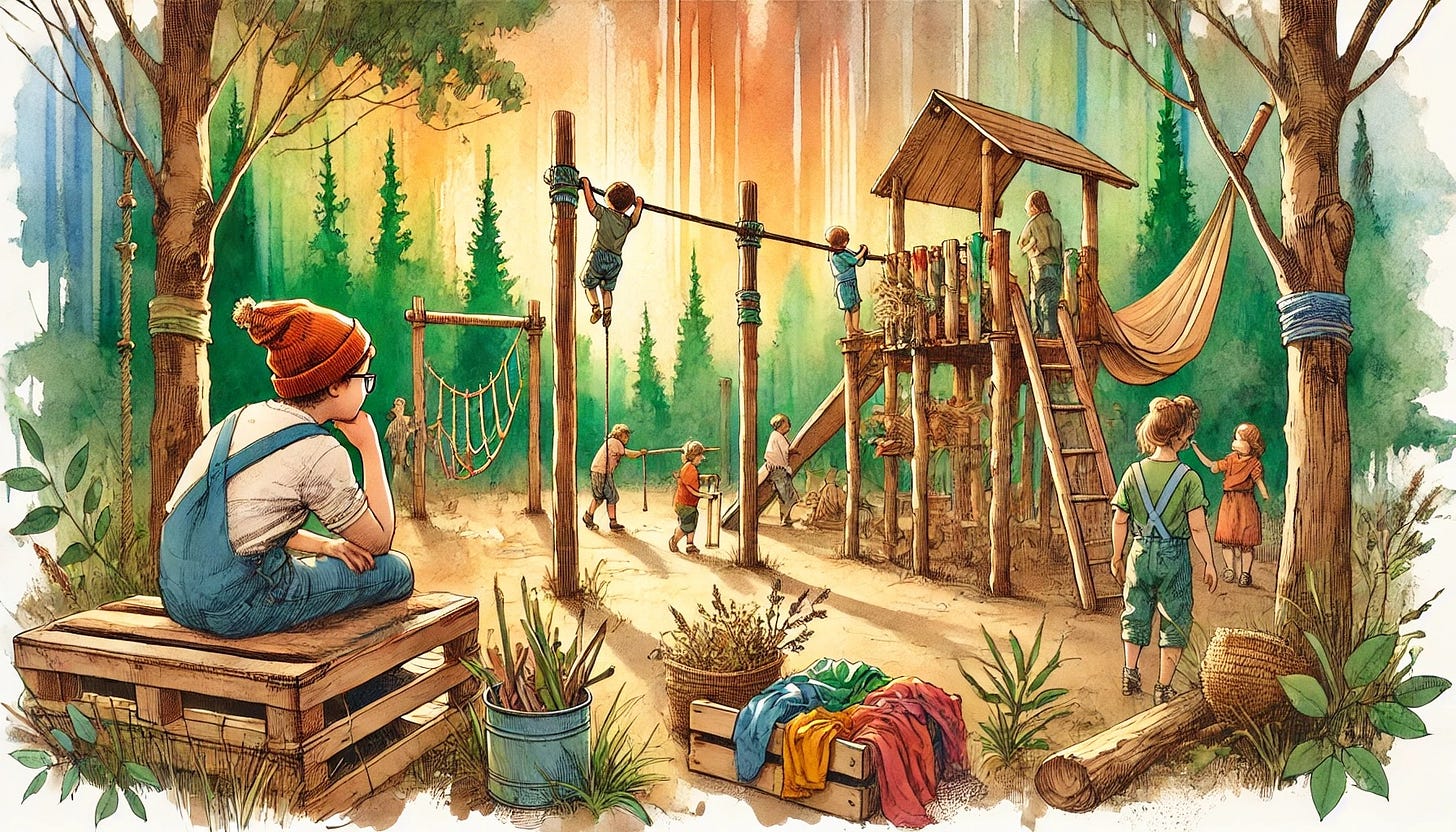
🕵️ Have you seen this child?
Calvin from Calvin and Hobbes
Picture a spunky six-year-old with a wild imagination, armed with nothing more than a cardboard box and an endless supply of creative energy. Calvin’s backyard is his universe: one moment, it’s an alien planet, the next, a medieval battlefield. His trusty tiger sidekick, Hobbes, is always by his side, though only Calvin sees him come to life.
Through his chaotic yet genius setups—like the Transmogrifier (a box that transforms Calvin into anything he wants to be) or the Duplicator (which hilariously backfires)—Calvin learns natural consequences firsthand. He discovers that big ideas often come with even bigger messes to clean up, but those missteps are the foundation of his resilience, problem-solving, and boundless creativity.
Calvin’s world is a masterclass in imaginative, self-directed play. He builds, experiments, and occasionally breaks things, but always emerges with a deeper understanding of his place in the world—and a laugh along the way.
Free play is nothing short of magic. Peter Gray, a leading psychologist and advocate for child-led learning, reminds us that play is essential for developing resilience, creativity, and problem-solving skills. It’s how kids practice being human—navigating risks, negotiating social rules, and exploring their world with curiosity and wonder. Historically, free play has been a cornerstone of childhood, and kids thrived when left to create, explore, and imagine on their own terms.
But somewhere along the way, this magic started to disappear.
Where’s Calvin?
Take a look around your neighborhood. Once-lively parks are now empty, or they’re filled with children whose every move is shadowed by a hovering adult. The decline in free play isn’t just anecdotal—it’s a well-documented trend with profound consequences.
Why is this happening?
Parental Fears — Stories of abductions or accidents, although statistically rare, have made parents more protective than ever. Social judgment plays a role too; parents worry they’ll be labeled neglectful if their child plays unsupervised.
Loss of Safe Play Spaces — Urbanization has reduced access to natural play areas, and traffic-heavy streets discourage exploration. Many neighborhoods lack parks, or the parks they have feel sterile and overly structured.
Structured Schedules and Screen Time — Kids’ days are packed with extracurriculars, leaving little room for unstructured play. When they do get free time, screens often take over, providing passive entertainment rather than active exploration.
Cultural Shifts — We’ve moved toward a hyper-focus on achievement, where every activity must be productive or skill-building. Play, which looks “unproductive” to adults, gets sidelined. Declining trust in communities means fewer parents feel comfortable letting their kids roam freely.
The Consequences of Play Deprivation
When play disappears, so do the developmental benefits it provides. Research shows that:
Cognitive Skills Decline: Problem-solving, creativity, and adaptability suffer without opportunities for unstructured exploration.
Emotional Health Deteriorates: Anxiety and depression rise in children who lack outlets for stress relief and risk-taking.
Social Skills Stagnate: Kids miss out on learning how to navigate conflicts and cooperate with peers.
Physical Fitness Drops: Free play often involves running, climbing, and jumping—activities critical for physical health. Without it, sedentary lifestyles take over.
Play deprivation doesn’t just affect kids—it weakens communities too. Empty parks mean fewer informal connections between neighbors, fewer opportunities for collective supervision, and a growing sense of isolation among families.
Reversing the tide of play deprivation requires a cultural shift—one that values play as a developmental necessity, not a luxury.
There are lots of fun and creative ways that parents and teachers are bringing free play back. I’ll just focus on two here: pop-up play events, and playworker certifications / badges.
Pop-Up Play: Bringing Adventure to Your Community
Ready to bring the magic of free play back into kids’ lives? Pop-up play events are an incredible way to transform underused spaces into hubs of creativity, exploration, and connection. These temporary play setups empower kids to lead their own adventures while helping parents and communities embrace the value of unstructured play.
Example: “Adventure Build Day”
Location: A local park, schoolyard, or community center.
Materials: Cardboard boxes, pallets, ropes, fabric, and paint. Child-safe tools like hammers, saws, and duct tape. Natural materials such as logs, rocks, and sticks.
Activities: Fort and Bridge Building: Kids use materials to design and construct their own play structures. Risk Zone: An area for climbing, balancing, and testing limits with natural elements. Imagination Challenges: Opportunities for kids to invent stories or games within the structures they create.
Parent Component: Parents observe from a designated area, practicing hands-off support while certified Playworkers or facilitators share tips on fostering independence. Parent discussion circles explore the benefits of free play and strategies for letting go.
Certification Opportunities: Kids can earn badges like:
Builder Badge: For constructing a fort or play structure.
Risk Explorer Badge: For safely navigating climbing and balancing challenges.
Imagination Architect Badge: For creating a story or scenario around their build.
Why Pop-Up Play Events Work
For Kids: They develop problem-solving skills, creativity, and resilience while having fun in a low-pressure environment.
For Parents: It’s a safe, structured way to practice letting go and seeing their kids thrive independently.
For Communities: These events activate public spaces, build social connections, and demonstrate the power of play to strengthen neighborhoods.
Hosting or attending a pop-up play event like “Adventure Build Day” could be the spark your community needs to rediscover the magic of childhood. Let’s turn empty parks into bustling hubs of creativity and connection—one cardboard box at a time!
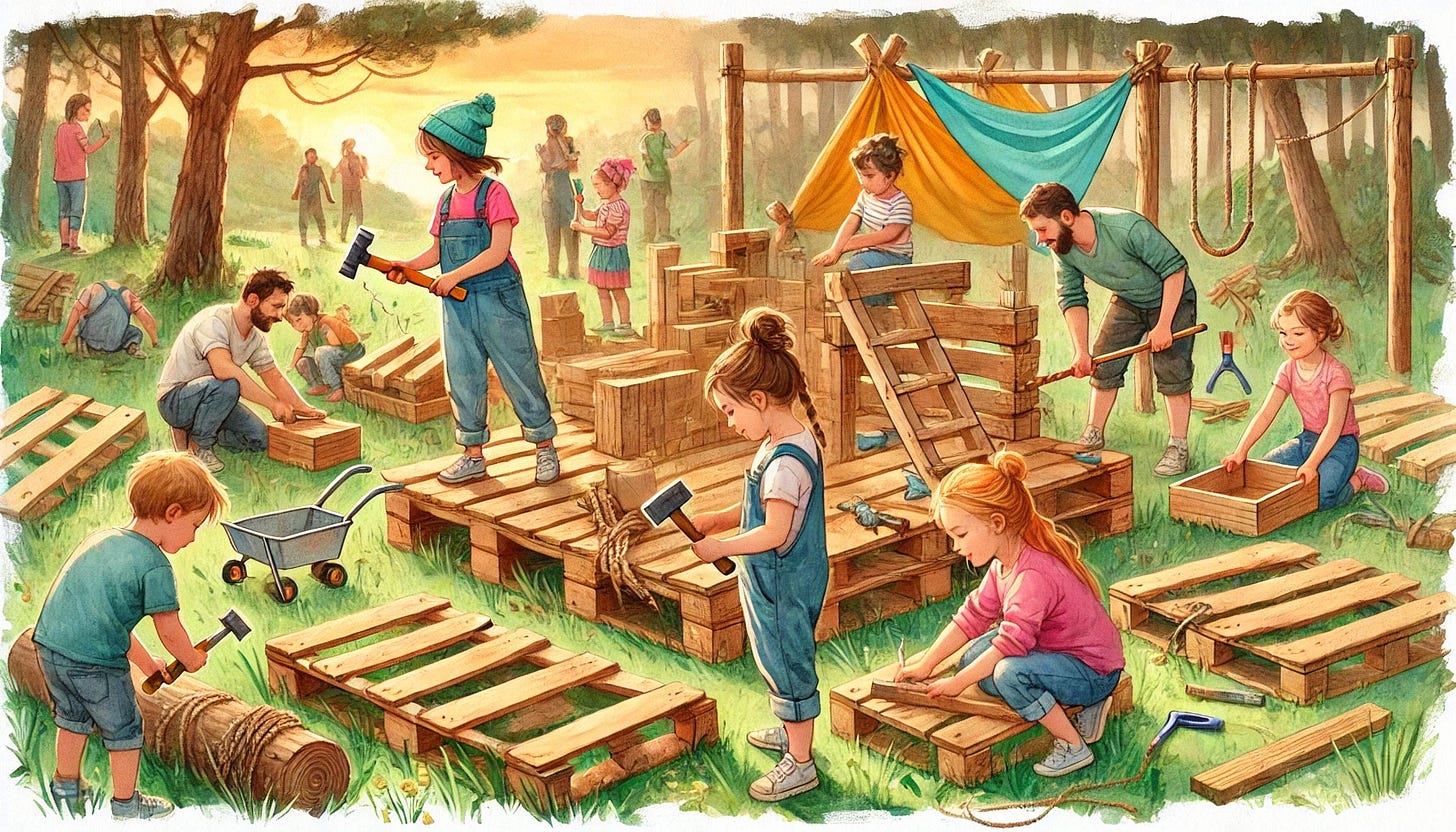
Badging: Turning Play Into Progress
I’ll admit: the idea of these Freedom Badges is my own brainchild. I have spent a good deal of time studying the educational value of badges — a topic we will deep dive in a future post — so I hope this does not come off as half-baked. Let me know your thoughts!
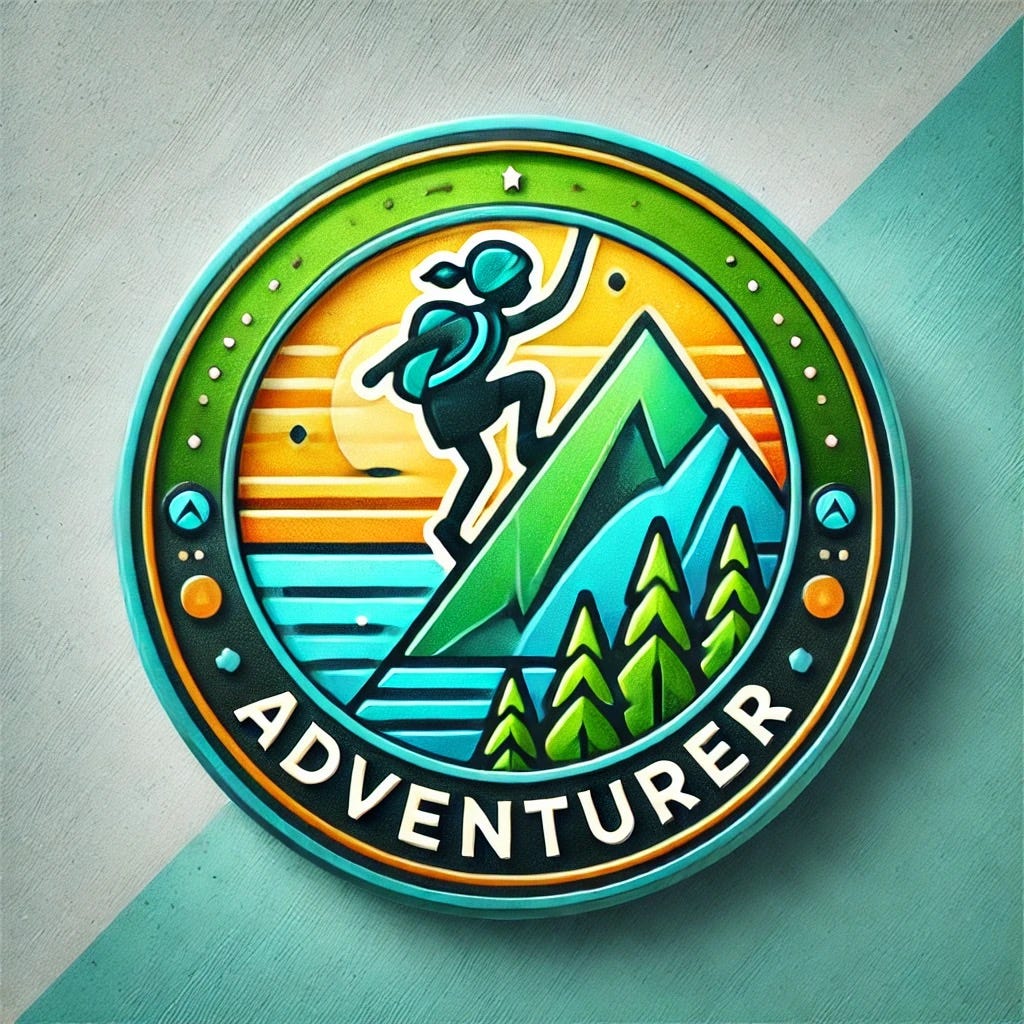
5 Badges for Kids
Kids thrive when they’re given the freedom to explore, create, and test their limits. These badges celebrate their achievements in developing independence, resilience, and creativity.
Risk Explorer Badge
What It Recognizes: Successfully navigating a challenge, like climbing a tree, crossing a creek, or balancing on a log. Why It Matters: Teaches kids how to assess and manage risks, building confidence and decision-making skills. How to Earn It: Climb a tree safely or try a new activity that feels a little scary at first.
Team Player Badge
What It Recognizes: Collaborating with peers to build, create, or solve a problem. Why It Matters: Fosters negotiation, cooperation, and leadership. How to Earn It: Work with friends to construct a fort or organize a game with self-made rules.
Imagination Architect Badge
What It Recognizes: Engaging in pretend play or creating something entirely new from open-ended materials. Why It Matters: Boosts creativity, problem-solving, and abstract thinking. How to Earn It: Use loose parts like cardboard, fabric, and rope to design a spaceship, castle, or secret hideout.
Bounce-Back Badge
What It Recognizes: Recovering from a mistake, failure, or small injury during play. Why It Matters: Builds emotional resilience and teaches kids to see setbacks as part of learning. How to Earn It: After a stumble or misstep (like falling off a climbing structure), get back up and try again.
Solo Explorer Badge
What It Recognizes: Spending time playing independently without direct adult supervision. Why It Matters: Encourages self-reliance, confidence, and a sense of personal agency. How to Earn It: Spend 15–30 minutes creating your own adventure, either in a backyard, park, or natural area.
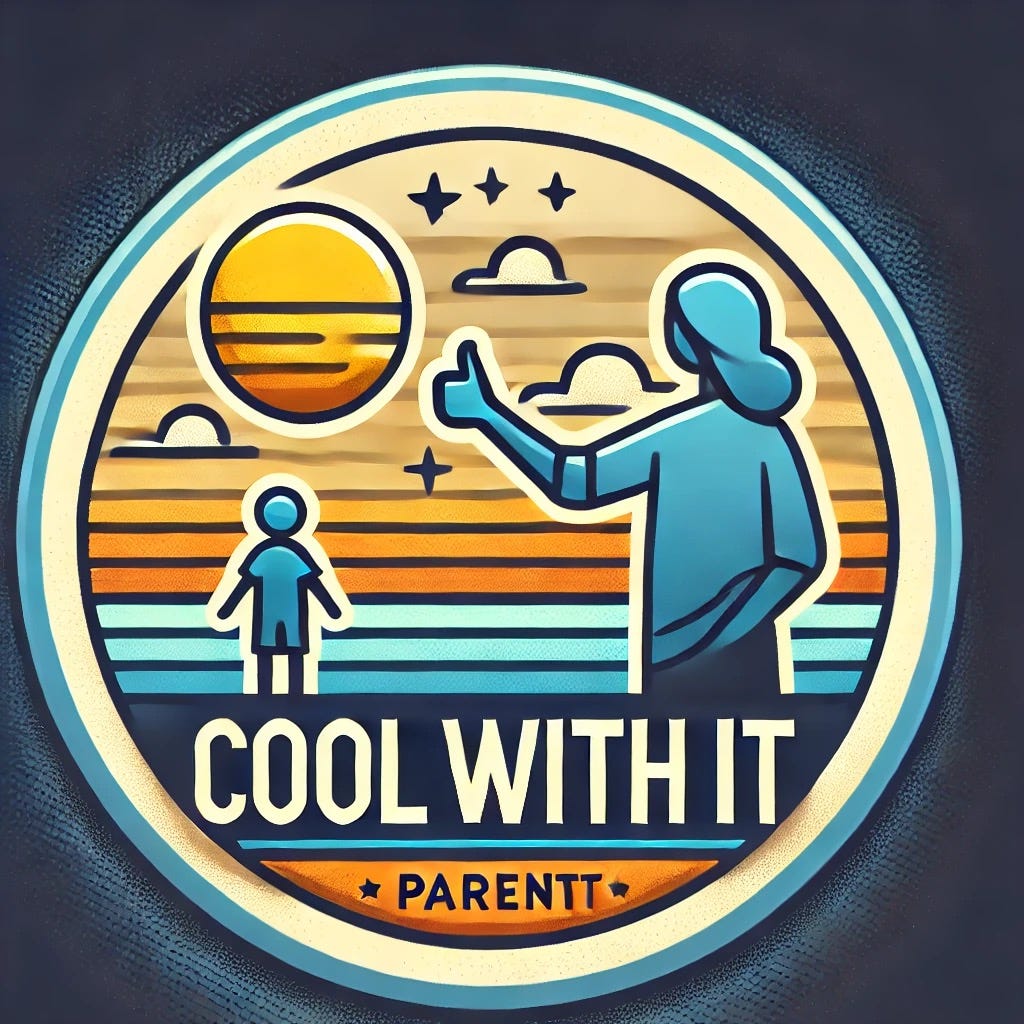
5 Badges for Parents
Parents play an essential role in enabling independence, even though letting go can be tough. These badges celebrate their progress in creating a culture of trust and play.
Observer Badge
What It Recognizes: Practicing the art of stepping back and letting kids take the lead. Why It Matters: Builds trust in children’s abilities and shows them you believe in their competence. How to Earn It: Sit nearby while your child plays without intervening unless safety is at risk.
Risk Manager Badge
What It Recognizes: Learning to distinguish between “risky” and “dangerous” play. Why It Matters: Encourages parents to allow healthy risk-taking, which is key for resilience. How to Earn It: Let your child try an activity that feels slightly nerve-wracking to you (e.g., climbing higher or exploring farther) while supervising calmly.
Calm in the Chaos Badge
What It Recognizes: Managing personal anxiety about children’s independence and risk-taking. Why It Matters: Kids pick up on parents’ emotions. Staying calm helps them feel confident and secure. How to Earn It: Use mindfulness or grounding techniques when you feel nervous about letting go.
Play Advocate Badge
What It Recognizes: Advocating for unstructured playtime in your family or community. Why It Matters: Shifts cultural norms toward valuing play as essential for development. How to Earn It: Join a parent group, speak to school officials about recess policies, or organize a neighborhood play day.
Trust Builder Badge
What It Recognizes: Gradually allowing children more independence over time. Why It Matters: Trust grows with experience—for both parents and kids. How to Earn It: Start by allowing short, supervised independent play sessions, then increase the time and space as confidence grows.
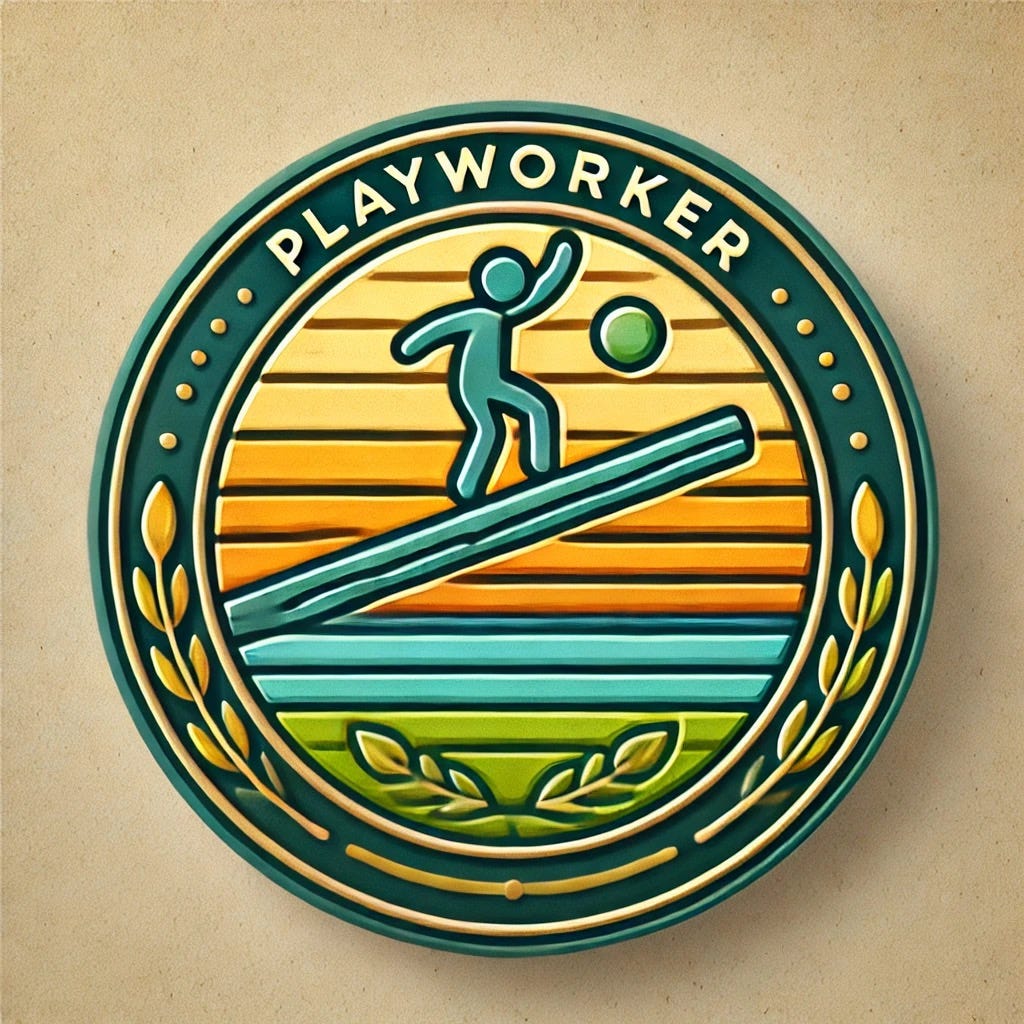
5 Badges for Teachers
** This is where we talk about the secret sauce: Playworkers! **
Playworkers are professionals trained to facilitate independent, self-directed play while providing minimal guidance. The concept comes from the UK’s adventure playground movement in the mid-20th century. These playgrounds emphasized loose parts, natural materials, and risk-taking, with playworkers acting as observers and safety advocates—not directors.
Teachers who embrace this philosophy could earn badges for mastering the art of fostering creativity, independence, and trust in kids.
Environment Designer Badge
What It Recognizes: Creating a play space that encourages exploration and imagination. Why It Matters: The right environment sparks creativity and enables self-directed learning. How to Earn It: Design a play area with loose parts, natural features, and open-ended materials.
Risk-Benefit Assessor Badge
What It Recognizes: Balancing the need for risk in play with safety considerations. Why It Matters: Taking calculated risks is essential for growth, but safety must be managed thoughtfully. How to Earn It: Conduct a risk-benefit analysis for a play activity and share your findings with parents or colleagues.
Child-Led Champion Badge
What It Recognizes: Supporting children in directing their own play without interference. Why It Matters: Builds autonomy and lets kids develop their own problem-solving skills. How to Earn It: Observe and facilitate play without stepping in to direct or solve problems unnecessarily.
Conflict Mediator Badge
What It Recognizes: Helping children navigate social conflicts during play in a constructive way. Why It Matters: Teaches kids negotiation and emotional regulation without imposing adult solutions. How to Earn It: Guide a group of children through a disagreement by asking open-ended questions and encouraging them to find their own resolution.
Resilience Facilitator Badge
What It Recognizes: Encouraging kids to take risks, learn from mistakes, and try again. Why It Matters: Builds a growth mindset and emotional strength in children. How to Earn It: Set up a challenging activity (like a climbing course or fort-building) and support children as they attempt—and sometimes fail—to succeed.
By earning these badges, playworkers and teachers not only honor the spirit of adventure playgrounds but also create lasting developmental benefits for the kids in their care.
🚀 Are we there yet?
Not quite—but we’re on the way.
Independent play and badging programs can transform how kids learn, grow, and explore. By creating these opportunities, we’re not just giving kids a childhood; we’re giving them the tools for a lifetime.
This sets the stage for our next topic: Why are free-range spaces, like adventure playgrounds, more common in rural areas? We’ll explore how parenting norms shift across landscapes.
In the meantime, I’d love to hear your thoughts on:
What’s your favorite memory of unstructured play as a child?
How would you adapt a badging program for your family or community?
Popcwcc vs What obstacles do you face when encouraging your kids to play independently?
Beans out!
🤓 You Might Also Like
In our next post, we’ll explore rural vs. urban parenting norms and the free-range movement. Until then, I recommend you check out the following:
Peter Gray’s Substack “Play Makes Us Human”: https://open.substack.com/pub/petergray?r=av41s&utm_medium=ios
Harry Shier’s excellent Introduction to Adventure Playgrounds (PDF): https://www.harryshier.net/docs/Shier-AdventurePlaygrounds.pdf
Pop Up Adventure Play — official playworker training resources and community: https://www.popupadventureplay.org/




